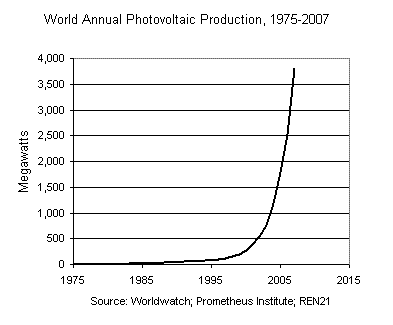Solar cell production growing rapidly
According to the Earth Policy Institute Indicators, production of photovoltaics (PV) jumped to 3,800 megawatts worldwide in 2007, up an estimated 50 percent over 2006. At the end of the year, according to preliminary data, cumulative global production stood at 12,400 megawatts, enough to power 2.4 million U.S. homes. The production of PVs has been growing by an average of 48% each year since 2002. 
Photovoltaics, which convert sunlight into electricity, include both traditional, polysilicon-based solar cell technologies and new thin-film technologies. Thin-film manufacturing involves depositing thin layers of photosensitive materials on glass, metal, or plastics. While the most common material currently used is amorphous silicon, the newest technologies use non-silicon- based materials such as cadmium telluride.
A key force driving the advancement of thin-film technologies is a polysilicon shortage that began in April 2004. While thin films are not as efficient at converting sunlight to electricity, they currently cost less and their physical flexibility makes them more versatile than traditional solar cells. Thin film grew from 4 percent of the market in 2003 to 7 percent in 2006. Polysilicon supply is expected to make up 20% of the solar market by 2010.
Germany has been the leading market for PV installations since 2004. By adding more than 1,050 megawatts in 2006, Germany became the first country to install more than one gigawatt in a single year. There are now more than 300,000 buildings with PV systems in Germany, triple the initial goal of the 100,000 Roofs Program launched in 1998. Growth is set to remain strong, as a feed-in tariff of 49¢ per kilowatt-hour will remain in place through 2009.
After almost tripling its PV production in 2006, China is believed to have more than doubled that output in 2007 making it second only to Germany in production. China’s solar market share has increased to 18% in 2007 over the 1% in 2003. China is now on track to become the largest PV producer in the world in 2008.
Despite China’s impressive production, PV prices are still too high for the average Chinese consumer. China only installed 25 megawatts of PV in 2006, exporting more than 90 percent of its PV production, mainly to Germany and Spain. China is planning a 100-megawatt solar PV farm in Dunhuang City in the northwestern province of Gansu.
Japan, the United States, and Spain round out the top four markets with 350, 141, and 70 megawatts installed in 2006, respectively. Japan now has over 250,000 homes with PV systems however the country is currently experiencing a decrease in the growth rate of PV installations resulting from the phase-out of the incentive program in 2005 and a limited domestic PV supply due to the polysilicon shortage.
Estimates for the United States indicate that PV incentives, including a tax credit of up to $2,000 available under the U.S. Energy Policy Act of 2005 to offset PV system costs, helped to achieve an 83% growth in installations in 2007.
With the help of a new building code that requires all new nonresidential buildings to generate a portion of their electricity with PV and a feed-in tariff, Spain tripled its PV installations in 2006 to 70 megawatts. In September 2007, a 20- megawatt PV power plant, currently the largest in the world, came online in the Spanish town of Beneixama and is produces enough electricity for 12,000 homes. By the end of 2008, PV installations in Spain are expected to exceed 800 megawatts, twice its original 2010 goal.
The average price for a PV module, excluding installation and other system costs, has dropped from almost $100 per watt in 1975 to less than $4 per watt at the end of 2006. With expanding polysilicon supplies, average PV prices are projected to drop to $2 per watt in 2010. For thin-film PV alone, production costs are expected to reach $1 per watt in 2010, at which point solar PV will become competitive with coal-fired electricity.
With concerns about rising oil prices and climate change spawning political momentum for renewable energy, solar electricity is poised to take a prominent position in the global energy economy.
Source: CleanEdge.
You can return to the main Market News page, or press the Back button on your browser.

